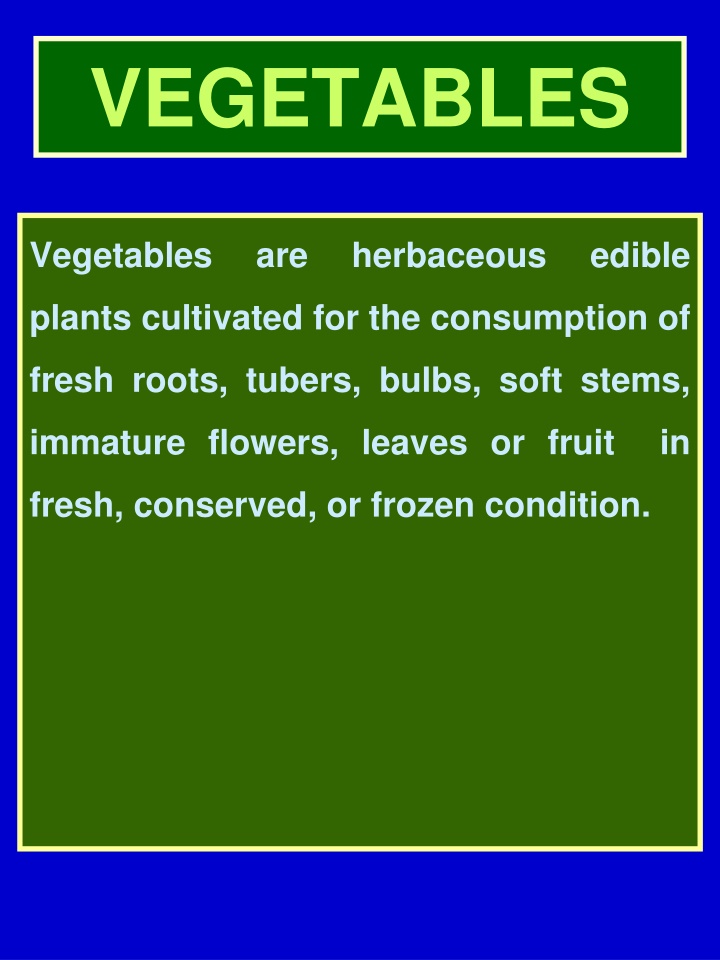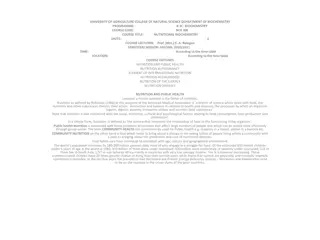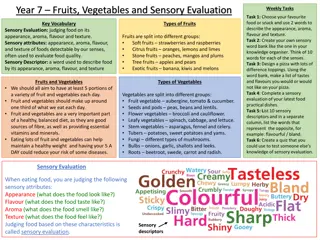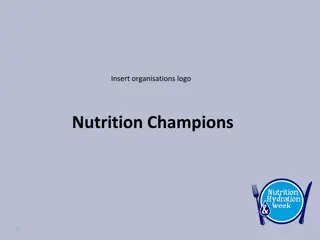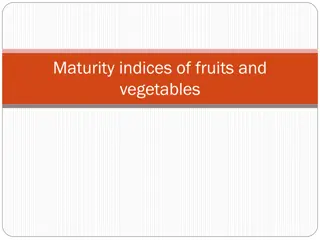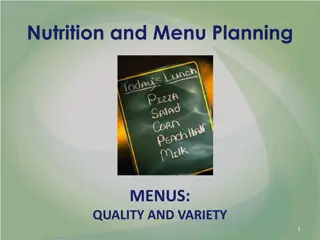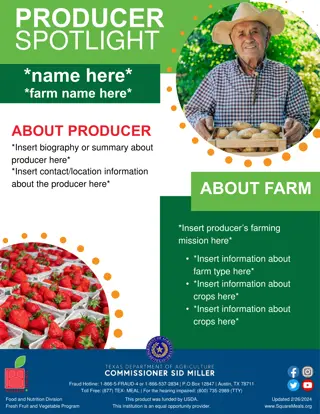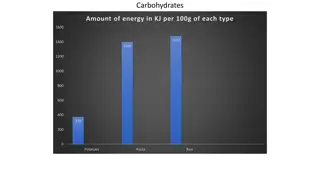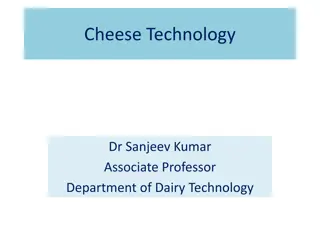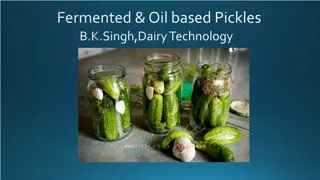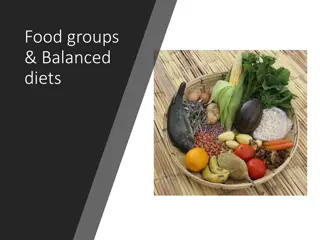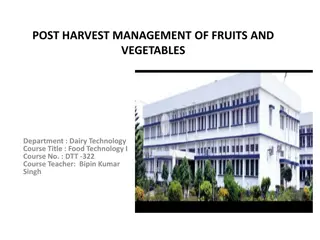Comprehensive Guide to Nutritional Value and Composition of Vegetables
Vegetables are herbaceous edible plants cultivated for consumption in various forms like fresh, cooked, or as salads. They are rich in essential nutrients such as protein, carbohydrates, vitamins, and inorganic salts. The tables provided detail the main nutrient constituents and composition of various vegetables, highlighting their water content, energy, fat, carbohydrates, and protein content per 100g of the edible part. Understanding the nutritional value and composition of vegetables can help in creating a balanced and healthy diet.
Download Presentation

Please find below an Image/Link to download the presentation.
The content on the website is provided AS IS for your information and personal use only. It may not be sold, licensed, or shared on other websites without obtaining consent from the author.If you encounter any issues during the download, it is possible that the publisher has removed the file from their server.
You are allowed to download the files provided on this website for personal or commercial use, subject to the condition that they are used lawfully. All files are the property of their respective owners.
The content on the website is provided AS IS for your information and personal use only. It may not be sold, licensed, or shared on other websites without obtaining consent from the author.
E N D
Presentation Transcript
VEGETABLES Vegetables are herbaceous edible plants cultivated for the consumption of fresh roots, tubers, bulbs, soft stems, immature flowers, leaves or fruit in fresh, conserved, or frozen condition.
Forms of consumption Fresh salads Cooked salads Fruit Cooked food Main food Secondary constituents used to improve taste
NUTRITIONAL VALUE Protein Carbohydrates Fat Inorganic salts Vitamins Antioxidant compounds Plant fibers
Table 1A: Main nutrient constituents in vegetables (in 100 g of edible part) Water (%) Energy (cal) Fat (g) Carbohydrates (g) Vegetable Protein (g) Cucumber 95.1 15 0.9 0.1 3.4 Endive 93.1 20 1.7 0.1 4.1 Sweet corn 72.7 96 3.5 1.0 22.1 Kohlrabi 90.3 29 2.0 0.1 6.6 Carrots 88.2 42 1.1 0.2 9.7 Watermelon 92.6 26 0.5 0.2 6.4 Zucchini 94.6 17 1.2 0.1 3.6 Squash 91.6 26 1.0 0.1 6.5 Cauliflower 91.0 27 2.7 0.2 5.2 Fresh onions 89.4 36 1.5 0.2 8.2 Dry onions 89.1 38 1.5 0.1 8.7 Cabbage 92.4 24 1.3 0.2 5.4 Brussel sprouts 85.2 45 4.9 0.4 8.3 Parsley 85.1 44 3.6 0.6 8.5 Fennel 90.0 28 2.8 0.4 5.1 Lettuce 94.0 18 1.3 0.3 3.5 Eggplant 92.4 25 1.2 0.2 5.6 Okra 88.9 36 2.4 0.3 7.6
Table 1B: Main nutrient constituents in vegetables (in 100 g of edible part) Water (%) Energy (cal) Fat (g) Carbohydrates (g) Vegetable Protein (g) Pea, fresh 78.0 84 6.3 0.4 14.4 Pea, dry Red beet Potato 11.7 87.3 340 43 24.1 1.6 1.3 0.1 60.3 9.9 76.0 86 2.1 0 20.8 Melon 90.6 33 0.8 0.3 7.7 Pepper Leek Broccoli Chicory 93.4 85.4 89.1 22 52 32 1.2 2.2 3.6 0.2 0.3 0.3 4.8 11.2 5.9 95.1 15 1.0 0.1 3.2 Radish 94.5 17 1.0 0.1 3.6 Celery 94.1 17 0.9 0.1 3.9 Swiss chard 91.1 25 2.4 0.3 4.6 Garlic 74.0 - 4.5 - 20.0 Spinach 90.7 26 3.2 0.3 4.3 Tomato 93.5 22 1.1 0.2 4.7 Green bean 90.1 32 1.9 0.2 7.1 Dry bean 10.9 340 22.3 1.6 61.3
Table 2A: Composition of vegetables in inorganic salts (mg per 100 g of edible part) Vegetable Ca P Fe Na K Cucumber 25 27 1.1 6 160 Endive 81 54 1.7 14 294 Sweet corn 41 51 0.5 8 372 Kohlrabi 3 111 0.7 280 Carrots 37 36 0.7 47 341 Watermelon 7 10 0.5 1 100 Zucchini 28 29 0.4 1 202 Squash 21 44 0.8 1 340 Cauliflower 25 56 1.1 13 295 Fresh onions 51 39 1.0 5 231 Dry onions 27 36 0.5 10 157 Cabbage 49 29 0.4 20 233 Brussel sprouts 36 80 1.5 14 390 Parsley 203 63 6.2 45 727 Fennel 100 51 2.7 - 397 Lettuce 68 25 1.4 9 264 Eggplant 12 26 0.7 2 214
Table 2B: Composition of vegetables in inorganic salts (mg per 100 g of edible part) Vegetable Ca P Fe Na K Pea, fresh 26 116 1.9 2 316 Pea, dry Red beet Potato 64 16 340 33 5.1 0.7 35 60 1005 335 8 - 0.5 - - Melon 14 16 0.4 12 251 Pepper 10 25 0.7 - - Okra 92 51 0.6 3 219 Leek 52 50 1.1 5 347 Broccoli 103 78 1.1 15 382 Chicory 18 21 0.5 7 182 Radish 30 31 1.0 18 322 Celery 39 28 0.3 126 341 Swiss chard 88 39 3.2 147 550 Spinach 93 51 3.1 71 470 Tomato 13 27 0.5 3 244 Green bean 56 44 0.8 7 132 Dry bean 144 425 7.8 19 1,196
Table 3A: Composition of vegetables in main vitamins (mg per 100 g of edible part) Vitamin (I.U.) Thiamin B1 (mg) Riboflavin B2 (mg) Niacin B3 (mg) Vit. C (mg) Vegetable Cucumber 250 0.03 0.04 0.2 11 Endive 3.300 0.07 0.14 0.5 10 Kohlrabi 20 0.06 0.04 0.3 66 Sweet corn 400 0.15 0.12 1.7 12 Carrots Watermelon 11.000 0.06 0.05 0.6 0.8 590 0.03 0.03 0.2 7 Zucchini 320 0.05 0.09 1.0 19 Squash 1.600 0.05 0.11 0.6 9 Cauliflower 60 0.11 0.10 0.7 78 Fresh onions 2.000 0.05 0.05 0.4 32 Dry onions Cabbage Brussel sprouts 40 130 0.03 0.05 0.04 0.05 0.2 0.3 10 47 550 0.10 0.16 0.9 102 Parsley Fennel 8.500 0.12 0.26 1.2 172 3.500 - - - 31 Lettuce 1.900 0.05 0.08 0.4 18 Eggplant 10 0.05 0.05 0.6 5 Okra 520 0.17 0.21 1.0 31
Table 3B: Composition of vegetables in main vitamins (mg per 100 g of edible part) Vitamin (I.U.) Thiamin B1 (mg) Riboflavin B2 (mg) Niacin B3 (mg) Vit. C (mg) Vegetable Pea, fresh 640 0.35 0.14 2.9 27 Pea, dry 120 0.74 0.29 3.0 - Red beet 20 0.03 0.05 0.4 10 Potato - 0.11 0.04 - 8-30 Melon 40 0.04 0.03 0.6 23 Pepper 770 0.09 0.06 1.7 235 Leek 40 0.11 0.06 0.5 17 Broccoli 2.500 0.10 0.23 0.9 113 Chicory Traces - - - - Radish 10 0.03 0.03 0.3 26 Celery 240 0.03 0.03 0.3 9 Swiss chard 6.500 0.06 0.17 0.5 32 Spinach 8.100 0.10 0.20 0.6 51 Tomato 900 0.06 0.04 0.7 23 Green bean 600 0.08 0.11 0.5 19 Dry bean - 0.65 0.22 2.4 -
CLASSIFICATION OF VEGETABLES Botanical taxonomy Edible part Requirements in temperature Cultivation cycle Pollination Photoperiod
Botanical classification Plant species Examples Pepper: Capsicum annuum spinach: Spinacia oleracea
Sub-category Botanical variety . . Brassica oleracea, var. botrytis: cauliflower var. italica: broccoli Var. capitata: cabbage Cultivated variety: (cv. = cultivated variety) e.g. tomato: Solanum lycopersicum, cv. Belladona)
CLASSIFICATION ACCORDING TO THE EDIBLE PART
CLASSIFICATION ACCORDING TO THE EDIBLE PART The edible part may be: 1. Underground plant organts 1. tuber: potato 2. Root tuber: red beet, carrot 3. Bulb: onion, garlic 2. Stem: asparagus, kohlrabi 3. Leaves: lettuce, endive 4. Unripe flowers: cauliflower, artichoke 5. Fruit: 1. Unripe fruit: cucumber, eggplant 2. Ripe fruit: tomato, watermelon
Table 4: Classification of vegetables according to their temperature requirements Cold season vegetables Warm season vegetables Cold-resistant Opt. T: 15 - 18 oC, Max >24 oC Moderately cold- sensitive Strongly cold- sensitive Cold tolerant Kohlrabi Artichoke Sweet corn Cucumber Onion * Cabbage Brussel sprouts Endive Carrot Cauliflower Green cowpea Tomato Green bean Pepper Sweet potato Watermelon Parsley Iceberg lettuce Pea Leek * Broccoli Chicory Radish Chinese cabbage Lettuce (Head) Red beet Potato Celery Swiss chard Zucchini Squash Eggplant Okra Melon Garlic * Spinach Asparagus *
Table 5: Vegetables requiring vernalization through exposure to cold temperatures to form reproductive organs Kohlrabi Fennel Carrot Red beet Onion Leek Cabbage Radish Brussel sprouts Celery Parsley Swiss chard
Table 6A: Classification of vegetables according to their pollination needs Insect-pollinated Wind-pollinated Self-pollinated Artichoke Sweet corn Endive Cucumber Dill Sweet potato Kohlrabi Pea Watermelon Zucchini squash Red beet Swiss chard Spinach Faba bean Lettuce Eggplant Carrot Potato Pepper Chicory Onion Tomato Cauliflower Common bean Cabbage Brussels sprouts Chinese cabbage Parsley Fennel Eggplant Okra Melon Leek Broccoli Radish Asparagus
Classification of vegetables according to the cultivation cycle Perennial Asparagus Artichoke Annual All other vegetables cultivated in temperate climates
Current trends in the market of fresh vegetables The percentage of fresh vegetables distributed trough markets is increasing large super Consumer demand for safe and high quality food has dramatically increased Quality vegetables and fruits is becoming compulsory certification of fresh
The importance of quality Product characteristic that depends on several factors and includes both objective, measurable quality traits as well as subjective, sensory characteristics. quality is a complex Nowadays, prescribed subjected to quality grading based on standards set by international or national authorities. most the vegetables market for are EU and other
The importance of quality The application of quality standards to fresh vegetables has increased the uniformity in size, presentation of produce. However, the characteristics related to flavour and aroma are not affected standards. maturity and vegetable quality by such Flavour and aroma are important in the market to gain reputation (e.g. a brand name) and get a premium price .
The importance of quality Furthermore, characteristics linked with food safe, i.e. the residuals of agrochemicals, are in most cases not taken into consideration when classes according standards. the quality grading to into quality Therefore, many state authorities as well as the European Union have established maximum residual limits (MRL) for specific agrochemicals and horticultural products.
The need for certification The increasing concern of consumers with the safe and quality of fresh vegetables and other food products originating from agriculture forced the large super market chains in Europe to establish a comprehensive system of certification. GLOBALG.A.P. (www.globalgap.org) (formerly EUREPGAP) Certification is based on a standard protocol of Good Agricultural Practices (GAP) GLOBALG.A.P. Fruit and Vegetables Standard
Certification and Market The application of good agricultural practices is aimed at minimising detrimental environmental impacts of farming operations, reducing the use of chemical inputs and ensuring a responsible approach to worker health & safety.
Certification and Market Certification of the production procedure according to the GLOBALGAP standard is a prerequisite for the product to be marketed by the joined retailers. In Greece and other Mediterranean countries, the introduction of the GLOBALGAP certification system had serious consequences on vegetable production, since it became a prerequisite for growers to export their products to the large fresh vegetable markets of Europe.
